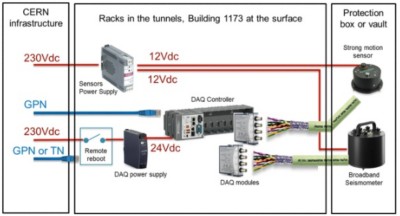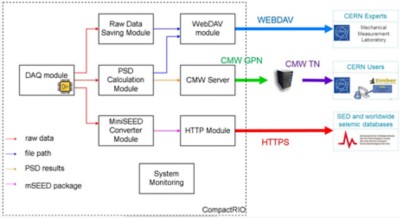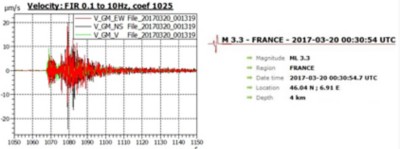CERN Creates a CompactRIO Ground Vibration Monitoring System as Part of the International Seismic Network
Kevin Develle, European Organization for Nuclear Research (CERN)

"We have successfully deployed three seismic stations at CERN and have detected earthquakes from different places around the world."
- Kevin Develle, European Organization for Nuclear Research (CERN)
The Challenge:
We needed to create a system to monitor both natural ground motion and industrial vibration with tight timing restrictions. The system should also allow persona-based access to data to share with CERN databases and international seismic databases.
The Solution:
We created a system based on the cRIO-9035 controller, two NI-9239 C Series modules, broadband seismometers, and strong motion sensors. We used the embedded FPGA in the LabVIEW Real-Time application to communicate through miniSEED and with the CERN infrastructure.
Ground Vibration Acquisition System
We developed a custom solution using CompactRIO instead of a seismic data logger from the market for three main reasons. First, we needed a DAQ system that would be easy to implement in the Large Hadron Collider (LHC) tunnel and robust to the harsh environments. Second, we needed the DAQ system to communicate with the CERN infrastrucutre so that we could easily analyse the data and store it in the LHC database. In addition, there was no system that could fully satisify the needs of measuring natural ground motion (broadband seismometer) and industrial vibration (strong motion sensor) related to High Luminosity LHC (HL-LHC) civil engineering activites.

We chose the cRIO-9035 controller with two NI-9239 C Series modules to meet these different requirements. We developed a LabVIEW Real-Time application to make use of the embedded FPGA.
We use the CompactRIO system to acquire, process, and share raw data in real time. The system sends the data to different users. The system sends raw data to SED, which redirects it toward the worldwide seismic databases. CERN users can access the power spectral densities. Only CERN experts can access a more complete version of the data. Each of this data is post-processed independently to fulfill the requirements of the users. If one of the modules fails, the other modules can continue streaming.
One of the challenges with this application was achieving the time accuracy required (1 ms). The CompactRIO internal clock has an accuracy of 40 ppm at 25° C, which can lead to 3 s of drift per day. Like any seismic data logger, we needed an external synchronization. Although we could use GPS synchronization with CompactRIO, that would require an additional GPS module, an antenna, and getting the GPS signal underground. As NTP service at CERN provides a time accuracy below 1 ms and does not require external hardware, we chose this reference to develop CERN seismic stations.

Another challenge was to work in cooperation with SED. The seismic station must send the data in SEED formats or at least in miniSEED format. SED is adding the additional metadata information directly on its server and integrating CERN into the international seismic network. A real-time miniSEED data package contains 512 bytes of data divided into two parts: a header and the recorded data. The data packages should be delivered with a 10 s latency. The header includes a network code, a channel identifier, a location identifier, a station identifier, a data quality indicator, a sequence number, a time stamp, the size of the record, the frequency of the record, and some additional separator in the header. After the header, the record is composed of binary data concatenated.
Thanks to all the information in the header, and depending on the latency targeted, one or several miniSEED data packages are sent together. The server can use the time stamp and sequence number to discard data if they arrive in a non-coherent order.

To be integrated in the international seismic network, we also needed to have a very robust system and receive notification in case of trouble. In case of network failure with a station, data would be stored locally and resent after. In the meantime, an independent machine would send a warning. We could install two power supplies to have redundancy in case of failure. C Series modules can monitor these and send a warning if one has a failure. In case of power break, an independent machine can send a warning and the data acquisition will restart automatically once power returns.
Summary
We have successfully deployed three seismic stations at CERN and have detected earthquakes from different places around the world.

We designed the network for compatibility with the LHC harsh environment and to track the ground motions between 30 s and 100 Hz, with amplitudes ranging from LHC ground motion up to 2 g. This wide range of measure helps us get accurate feedback on the ground stability in LHC tunnels.
The data, made available at CERN and for worldwide seismic organisations, can be used for very diverse applications. The study of the impact of earthquakes on the LHC can guide the GEothermie 2020 project, which aims to develop the use of geothermal energy in the Canton of Geneva without impacting CERN experiments. Scientists plan to use the data in the HL-LHC framework project to upgrade the LHC. Vibration levels will be of particular interest during the excavation of the new shafts. Finally, the network will be used as a valuable reference for monitoring vibration levels in the LHC on a long-term basis.
The systems have run 24/7 for several months and are fullfilling all requirements.
Future development may be done to get data at SED within two seconds instead to the actual 10 seconds.
Author Information:
Kevin Develle
European Organization for Nuclear Research (CERN)
kevin.develle@cern.ch